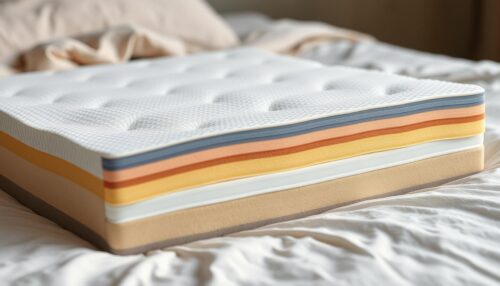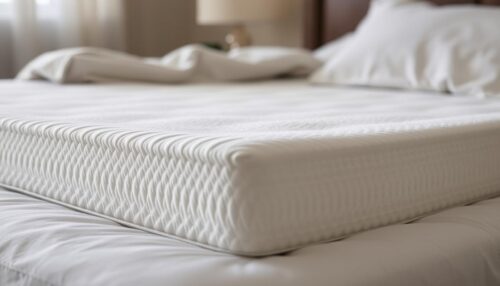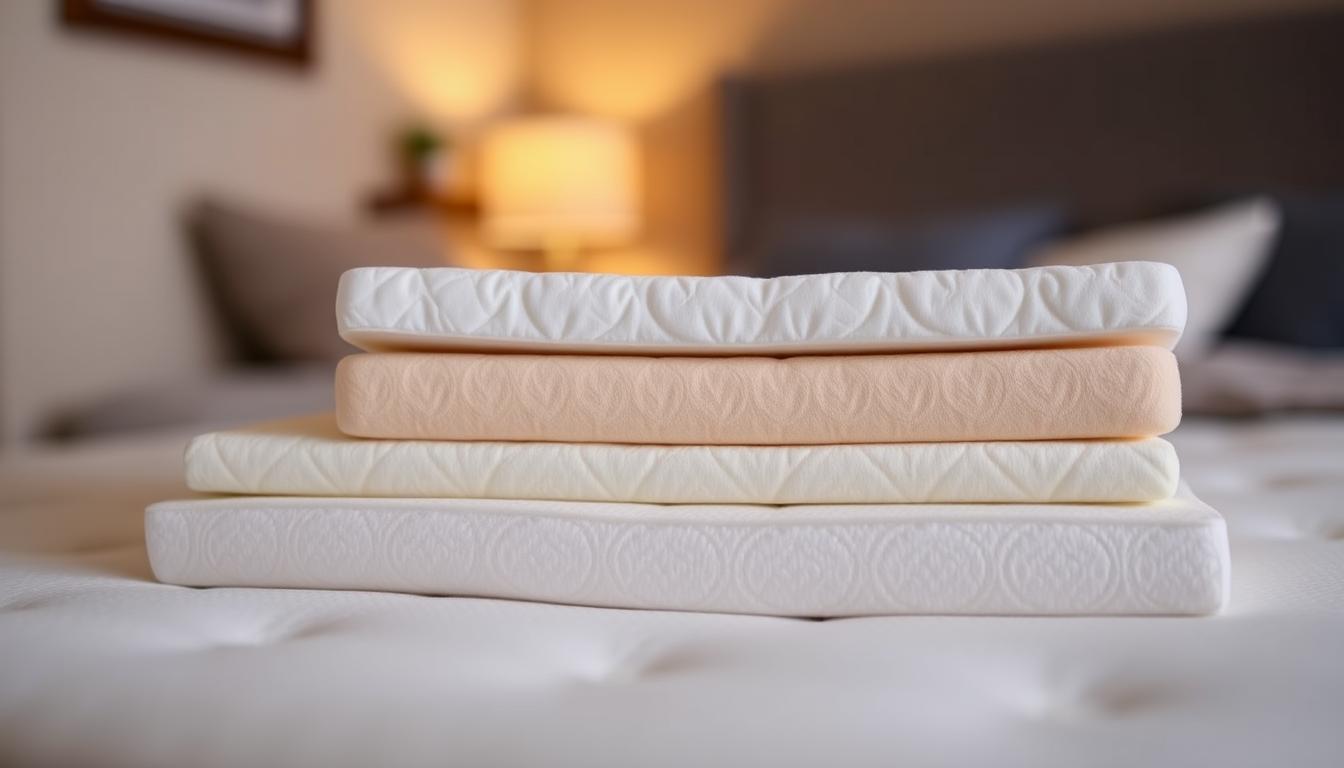Disclosure
This website is a participant in the Amazon Services LLC Associates Program, an affiliate advertising program designed to provide a means for us to earn fees by linking to Amazon.com and affiliated sites.
Are you searching for the best memory foam mattress topper thickness? You’re not alone. There are many options, making it hard to choose the right one. The thickness of your topper is key for comfort and support.
Key Takeaways
- Memory foam mattress toppers usually range from 2 to 6 inches thick.
- At least 2 inches of memory foam is needed to feel a difference in comfort.
- 3-4 inch toppers are great for pain management and injury recovery.
- Thicker toppers (3-4 inches) offer more cushioning and support for worn mattresses.
Understanding Memory Foam Mattress Toppers
Memory foam mattress toppers are a great addition to many beds. They make your bed more comfortable and supportive. These toppers sit on top of your mattress, giving you a sleep experience just right for you.
They offer many benefits, like better pressure relief and a longer-lasting mattress. These toppers can really change how well you sleep.
What Is a Memory Foam Mattress Topper?
A memory foam mattress topper is a thick, soft foam that molds to your body. It’s not just a mattress pad or protector. It’s thicker and gives more comfort and support.
Benefits of Using a Mattress Topper
- Improved pressure relief to alleviate pain in the shoulders, hips, and back
- Enhanced motion isolation, reducing disruptions from a sleeping partner
- Prolonged mattress lifespan by adding an extra layer of cushioning
- Tailored comfort for different sleep positions and body types
- Potential relief for conditions like arthritis, fibromyalgia, and chronic pain
Key Features to Consider
When picking a memory foam mattress topper, think about the thickness, density, and firmness. The optimal memory foam topper thickness is usually between 2 to 4 inches. The mattress topper height and mattress topper depth also matter for comfort and support.
Choosing the right memory foam mattress topper can greatly improve your sleep. It offers the perfect mix of comfort and support for a good night’s sleep.
Why Thickness Matters
Thickness is key when picking the best memory foam mattress topper. It affects how comfy and supportive it is. The right thickness depends on your sleep style, body weight, and mattress condition.
How Thickness Affects Comfort
Thicker toppers, about 3-4 inches, are great for side sleepers. They help keep your spine straight and ease pressure. Back sleepers might like a 2-3 inch topper for the right mix of softness and support. For stomach sleepers, a 1-2 inch topper is best to keep your spine aligned.
The Impact on Support
Thicker toppers, over 3 inches, boost support and comfort on old, sagging mattresses. This is super helpful for back pain sufferers. The extra cushioning keeps your spine in line.
Longevity of Different Thicknesses
| Topper Thickness | Longevity |
|---|---|
| 2-3 inches | Typically 2-3 years |
| 4 inches and above | Potentially 3-5 years |
The life of a memory foam topper also depends on how you use it, care for it, and the foam quality. Thicker toppers last longer but are harder to move and keep clean.
When picking a topper, think about comfort, support, and how long it lasts. This way, you’ll get the best sleep for your money.
Recommended Thicknesses for Different Sleepers
Choosing the ideal mattress topper thickness depends on how you sleep. Each sleep position needs different support and cushioning for comfort and spine alignment. Let’s look at the best thicknesses for side, back, and stomach sleepers.
Side Sleepers: 3-4 Inches
Side sleepers need a thicker topper, 3 to 4 inches deep. This extra cushioning eases pressure on hips and shoulders. The optimal memory foam topper thickness for side sleepers supports the spine well.
Back Sleepers: 2-3 Inches
Back sleepers do best with a topper that’s 2 to 3 inches thick. This thickness balances comfort and support, keeping the spine straight. The ideal mattress topper thickness for back sleepers also helps the lower back.
Stomach Sleepers: 1-2 Inches
Stomach sleepers need a thinner topper, 1 to 2 inches thick. This prevents too much sinking and keeps the spine aligned. The optimal memory foam topper thickness for stomach sleepers prevents feeling stuck in the mattress.
Your personal preferences and sleep needs are key. Think about your main sleep position when picking a topper thickness. A trial or a good return policy can help you find the right one.
Choosing the Right Density
When picking a memory foam mattress topper, the foam’s density matters a lot. It’s as key as the memory foam topper thickness or mattress topper depth. Foam density shows how heavy it is per cubic foot. This affects how long it lasts and how well it supports you.
Understanding Foam Density
Higher density foam, 4-5 pounds per cubic foot, gives better support and lasts longer. Lower density foam, 2-3 pounds per cubic foot, feels softer and molds to your body better. The foam’s density and thickness together decide how well it works and feels.
How It Relates to Thickness
People who are heavier might need a denser foam topper. It helps prevent sinking too much. Lighter people might like a medium density foam for comfort and support.
Ideal Density for Different Sleeper Types
- Side sleepers usually do well with denser foam toppers, 4-5 pounds per cubic foot. It cushions their shoulders and hips.
- Back sleepers might like medium density foam, 3-4 pounds per cubic foot. It offers the right mix of support and comfort.
- Stomach sleepers might prefer softer foam, 2-3 pounds per cubic foot. It helps them avoid feeling trapped in the mattress.
Finding the right density for your memory foam mattress topper depends on your needs. It’s about finding the perfect balance for comfort and support.

Pros and Cons of Thicker Toppers
Choosing the right mattress topper thickness has its ups and downs. Thicker toppers, from 3 to 4 inches, offer great comfort and support. But, they also have some downsides.
Advantages of Thicker Options
- They give more cushioning and pressure relief, great for side sleepers and those with old mattresses.
- They contour to your body’s shape for a more personal sleep feel.
- They last longer, keeping their shape and comfort over time.
Drawbacks to Consider
- They might make your bed warmer, which can be a problem for some.
- They can be hard to move around on, making it tough to change positions at night.
- They make your bed higher, which might not fit with lower bed frames.
Combining Thickness and Mattress Type
Choosing the right topper thickness depends on your mattress’s condition and firmness. Thicker toppers, like 4-inch ones, are good with firmer mattresses for a plush feel. Softer mattresses do better with thinner toppers, 2 to 3 inches, for a balanced feel.
The right topper thickness depends on your preferences, sleep position, and mattress condition. A trial at home or a good return policy can help you find the best comfort and support for sleep.
Pros and Cons of Thinner Toppers
Thickness is key when picking mattress toppers. Thicker toppers (3-4 inches) feel luxurious and plush. But, thinner ones (1-2 inches) have their own good points and downsides. Knowing these can help you choose the right one for you.
Benefits of Thinner Toppers
Thinner toppers are cheaper. They add a bit of comfort without changing your mattress too much. They’re also light and easy to move, great for changing your bed setup or moving your bedding.
Potential Disadvantages
Even though they’re cheaper and easy to move, thinner toppers might not give as much support. They might not be enough for people who are heavier or want a lot of comfort.
Recommendations for Specific Types
For stomach sleepers or those who like firmer mattresses, thinner toppers (1-2 inches) are good. They make a firm mattress a bit softer without losing support. If you want more comfort or need more pressure relief, a thicker mattress topper might be better.
Firmness Levels vs. Thickness
Finding the right memory foam mattress topper is all about firmness and thickness. These two factors are key to comfort and support. They greatly affect how well you sleep.
How Firmness Affects Comfort
Firmness levels change how comfortable a memory foam topper feels. Softer toppers give more cushioning, fitting your body and easing pressure. Firmer toppers offer better support, keeping your spine straight and your posture right.
Options for Different Preferences
Many brands offer various firmness levels in the same thickness. For example, a 3-inch memory foam topper might come in soft, medium, and firm. This lets you pick the firmness that’s just right for you.
Finding the Right Balance
Finding the right mix of firmness and thickness depends on your sleep position and body type. Side sleepers often prefer thicker, softer toppers (3-4 inches) to ease pressure. Back and stomach sleepers might like medium-firm options (2-3 inches) for better spine alignment. The best mix is what feels good to you, so try different ones.
Understanding how firmness and thickness work together helps you choose the optimal memory foam topper thickness. This way, you get the perfect comfort and support for your sleep needs.
Maintaining Your Mattress Topper
Keeping your mattress topper in good shape is important. It helps it last longer. Whether it’s 2 inches or 4 inches thick, a few simple steps can keep it comfy and supportive.
Cleaning and Care Tips
Use a good mattress protector to keep your topper clean. It stops dust, spills, and dirt. Turn your topper often to make it wear evenly.
For small stains, use a mild soap and water. But don’t soak it.
When to Replace Your Topper
Memory foam toppers usually last 3 to 5 years. You might need a new one if it’s too flat or not comfy anymore. Thicker toppers might be harder to clean but last longer.
Signs of Wear and Tear
Watch for signs it’s time for a new topper. Look for mattress topper depth issues, indentations, or less support. Fixing these problems early keeps your topper at the right recommended mattress topper thickness.

By taking care of your topper and knowing when to replace it, you’ll get the most out of it. The right mattress topper depth is key to a good night’s sleep.
Popular Brands and Their Thickness Options
Looking for the best memory foam topper thickness can be easier with top brands. They offer many choices to fit different tastes and budgets. You can find a variety of mattress topper heights.
Tuft & Needle
Tuft & Needle is a big name in mattresses. They have a 2-inch memory foam topper made of Adaptive Foam. It’s soft and comfy, yet keeps your mattress feel the same.
Tempur-Pedic
Tempur-Pedic is famous for TEMPUR material. They have toppers in 1.5 inches, 2 inches, and 3 inches. These toppers give great pressure relief and support.
Lucid
Lucid has many memory foam toppers, from 2 inches to 4 inches. They have gel-infused and lavender-infused ones too. This meets many comfort and sleep needs.
These brands show there are many memory foam topper thicknesses out there. You can pick the perfect height and support for better sleep.
Conclusion: Finding Your Ideal Thickness
Choosing the right mattress topper thickness is very personal. It depends on your needs, sleep position, and mattress condition. Your personal preferences should guide you to the best thickness for your sleep setup.
Personal Preferences Matter
When picking the right mattress topper thickness, think about your comfort and support needs. Do you like a soft, cloud-like feel or a firmer surface? The thickness should match your sleep needs. Consider your body weight, sleep position, and any health issues or pain.
Test Before You Commit
Try different topper thicknesses before buying. Many stores offer trial periods or returns. This lets you see how a few inches can change your sleep. Testing options helps you find the perfect balance of comfort, support, and durability.
Investing in Your Sleep Quality
The best mattress topper thickness boosts your sleep quality and well-being. The cost is worth it for better sleep and a longer mattress life. Investing in your sleep health means better rest, less pain, and more daily productivity.

